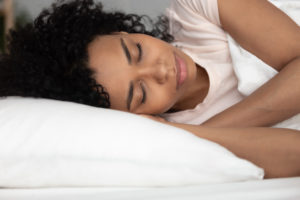REM Sleep: What It Is and Why It’s Important
- Rapid eye movement or REM sleep is the fourth out of four total stages of sleep.
- REM sleep is characterized by relaxed muscles, quick eye movement, irregular breathing, elevated heart rate, and increased brain activity.
- Most adults need about two hours of REM sleep each night.
- REM sleep plays a role in memory consolidation, emotional processing, brain development, and dreaming.
Rapid eye movement (REM) sleep goes by many names, including active sleep, desynchronized sleep, paradoxical sleep, rhombencephalic sleep, and dream sleep. Many people have been told REM sleep is the stage of sleep in which you dream, but REM is involved in a host of important functions, from brain development to emotional processing.
We explore the mysteries of REM sleep, why we need REM sleep, what happens when we don’t get enough REM sleep, and the sleep disorders associated with this stage of sleep.
What Is REM Sleep?
Rapid eye movement (REM) sleep is a stage of sleep associated with dreaming and memory consolidation . REM sleep was first discovered in the 1950s, when scientists studying sleeping infants noticed that there were distinct periods when their eyes moved rapidly from side to side. These rapid eye movements, or REMs, earned REM sleep its name.
Are You Getting Enough REM Sleep?
A variety of issues can cause degrade your sleep quality. Answer three questions to understand if it’s a concern you should worry about.
What Happens During REM Sleep?
During REM sleep, your eyes move rapidly behind your closed eyes, your heart rate speeds up, and your breathing becomes irregular. In contrast to other stages of sleep, in which your brain waves slow down, your brain is highly active during REM sleep, and your brain waves become more variable.
During REM sleep, much of your body operates similarly to how it does when you’re awake, except your eyes are closed and you experience a temporary loss of muscle tone. Researchers have hypothesized that this is a protective measure, meant to stop you from acting out your dreams and injuring yourself. However, now that scientists know we can experience dreams during non-REM sleep stages when our bodies are not paralyzed, this hypothesis is losing steam.
Various land-based species experience REM sleep, including humans and other mammals, reptiles like the Australian bearded dragon, and most birds. Although, REM sleep can look different depending on the species. For example, owls don’t experience actual rapid eye movements during REM sleep since they can’t move their eyes in their skulls. And, some birds only lose muscle tone in certain areas, like the neck, during REM sleep, so their head can rest while they keep standing on one foot.

When Does REM Sleep Occur?
You experience your first cycle of REM sleep about 60 to 90 minutes after falling asleep. As part of a full night’s sleep, you cycle through four stages of sleep multiple times: three stages of non-REM sleep, followed by one stage of REM sleep . Each cycle through all the sleep stages takes 90 to 120 minutes to complete. With each new cycle, you spend increasing amounts of time in REM sleep, with most of your REM sleep taking place in the second half of the night.
Each stage of sleep is distinct:
- Stage 1 (Light Sleep): As your brain slows down, low-amplitude mixed-frequency (LAMF) activity replaces the alpha brain waves that took over as you became drowsy. Your body has some muscle tone, and your breathing is regular.
- Stage 2 (Light Sleep): Your heart rate and body temperature both decrease. Sleep spindles and K-complexes, specific brain wave patterns, begin occurring as you continue transitioning toward deep sleep.
- Stage 3 (Deep Sleep): Your brain waves at this stage, called delta waves, are at their slowest of the night. Waking you is difficult, and those who are roused from this stage experience sleep inertia, a short period of fogginess and impaired cognitive performance. In deep sleep, your body physically repairs itself, boosting your immune system and restoring your bones, muscles, and tissue.
- Stage 4 (REM sleep): Your brain activity in this stage looks similar to how it looks when you are awake. You experience a loss of muscle tone, except for your eyes, which move rapidly. Your breathing becomes irregular and your heart rate rises.


REM Vs. Non-REM Sleep
REM sleep is one of the most fascinating stages of sleep, in part because it’s so different from other stages of sleep. In non-REM sleep, your eyes don’t move, your brain waves are much slower, and you maintain some muscle tone. Traits unique to REM sleep that differentiate it from non-REM sleep include:
- Brain wave activity that’s more similar to wakefulness than any other stage of sleep
- Complete loss of muscle tone vs. the partial muscle tone of non-REM sleep
- Irregular breathing vs. the steady, slower breathing of non-REM sleep
- A rise in heart rate vs. the slowdown experienced in non-REM sleep
- The ability to be awoken more easily than during non-REM sleep
Why Is REM Sleep Important?
All sleep is important, but REM sleep in particular plays an important role in dreaming, memory, emotional processing, and healthy brain development.
- Dreaming: A majority of your dreams take place during REM sleep. However, REM is not the only stage in which dreams occur — that’s actually a common myth about sleep. That said, the dreams you experience in REM sleep are usually more vivid than non-REM sleep dreams.
- Emotional Processing: Your brain processes emotions during REM sleep. Dreams, which are more vivid in REM sleep, may be involved in emotional processing. Also, your amygdala, the part of your brain that processes emotions, activates during REM sleep.
- Memory Consolidation: During REM sleep, your brain processes new learnings and motor skills from the day, committing some to memory, maintaining others, and deciding which ones to delete. Some memory consolidation also takes place in deep sleep , a non-REM stage.
- Brain Development: Researchers hypothesize REM sleep promotes brain development, since newborns spend most of their sleep time in REM. Adding to the evidence is that animals born with less developed brains, such as humans and puppies, spend even more time in REM sleep during infancy than those that are born with more developed brains, like horses and birds.
- Wakefulness Preparation: REM sleep, through its activation of our central nervous system, might help us get ready to wake back up. This may explain why we spend increasing amounts of time in REM sleep as the night progresses and why we are easier to wake up during this stage.
How Much REM Sleep Do You Need?
We need the most REM sleep as infants and children, when our brains are still developing. Newborn babies spend eight hours in REM sleep each day. By adulthood, we only need an average of two hours of REM sleep each night.
Like humans, most mammals also spend a greater proportion of their sleep time in REM sleep when they are infants than they do as adults. However, some mammals, like horses and elephants, can get by with little to no REM sleep, while cats, platypuses, and ferrets may spend up to eight hours each day in REM sleep.
Your body alters your sleep duration both over the course of your life and from day-to-day according to your biological and energetic needs. Similarly, how much time you spend in the specific stages of sleep, including REM, can vary from night to night based on what your body needs.
Both animal and human studies have documented increased REM sleep after learning. In a study of rats, those who learned a new maze spent more time in REM sleep for nearly a week afterward. Another study monitored the impacts of sleep on the working memory of healthy college students. The group of students that napped in between tests had higher accuracy and results showed the more time they spent in REM sleep during their nap, the higher their accuracy.
What Happens If You Don’t Get Enough REM Sleep?
Multiple studies of both humans and animals suggest that being deprived of REM sleep interferes with memory formation. However, memory problems associated with a loss of REM sleep could be due to overall sleep disruption, since those often occur together. Also, studies of the few rare individuals who do not experience REM sleep show that they do not experience problems with memory or learning. That said, REM sleep deprivation disrupts the brain’s ability to generate new cells. More research is needed to better understand the effects of REM sleep deprivation.
In general, missing out on sleep isn’t recommended. Sleep affects various aspects of your overall health, from your mood to your immune system. When you don’t get enough sleep, you experience sleep deprivation. Signs of sleep deprivation can include:
- Difficulty concentrating during the day
- Excessive daytime sleepiness
- Forgetfulness or poor memory
Over time, chronic sleep deprivation is linked to health conditions like diabetes, depression, obesity, and cardiovascular disease.
Without adequate sleep, your cognitive performance will decline. You may find yourself forgetting things more often, as working memory is highly affected by sleep deprivation. In fact, short sleepers, who regularly sleep fewer than six hours per night, can experience the same impairments to their working memory as people who haven’t slept for two nights in a row. Since you get most of your REM sleep in the second half of the night, short sleepers spend less time in REM . Certain medications, such as those commonly used to treat anxiety and depression, may also suppress REM sleep.
Sleep Disorders Associated With REM Sleep
Certain sleep disorders are associated with abnormal REM sleep. These include REM sleep behavior disorder (RBD), narcolepsy, and nightmare disorder :
- REM Sleep Behavior Disorder (RBD): People with RBD don’t always experience muscle paralysis during REM sleep, so sometimes they act out their dreams. They may shout, punch, kick, or jerk in their sleep, which can lead to them injuring themselves or their sleep partner. RBD may be caused by a breakdown in the area of the brainstem responsible for regulating REM sleep. RBD often precedes the development of a neurodegenerative disease.
- Narcolepsy: When they’re awake, people with narcolepsy can experience episodes of cataplexy. Cataplexy involves a sudden loss of muscle tone and is thought to occur because a person falls into REM sleep instantly, from wakefulness. Other symptoms of narcolepsy include excessive daytime sleepiness, disrupted REM sleep, and hypnagogia, or dream-like hallucinations that occur right before falling asleep. Narcolepsy appears to be caused by a loss of orexin neurons in the hypothalamus.
- Nightmare Disorder: Nightmares usually occur during REM sleep. A person with nightmare disorder regularly experiences intense and distressing nightmares. Nightmare disorder can be brought on by stress, childhood trauma, and other frightening experiences.
- Obstructive Sleep Apnea (OSA) and Central Sleep Apnea (CSA): Although sleep apnea disorders do not only occur during the REM sleep stages, they do affect the amount of REM sleep a person obtains. In sleep apnea, a person experiences lapses in breathing as they sleep. When these lapses occur during REM, they often move to a lighter sleep cycle in order to continue breathing. As a result, people with sleep apnea tend to spend less time in REM sleep than others and experience excessive daytime sleepiness.
When to Talk to Your Doctor
If you notice symptoms of sleep deprivation, or believe you might have a sleep disorder like REM sleep behavior disorder or nightmare disorder, talk to your doctor. They can help you determine the cause of your sleep issues and develop a treatment strategy to improve your sleep.

Still have questions? Ask our community!
Join our Sleep Care Community — a trusted hub of sleep health professionals, product specialists, and people just like you. Whether you need expert sleep advice for your insomnia or you’re searching for the perfect mattress, we’ve got you covered. Get personalized guidance from the experts who know sleep best.
References
10 Sources
-
Peever, J., & Fuller, P. M. (2017). The biology of REM sleep. Current Biology, 27(22), R1237-R1248.
https://pubmed.ncbi.nlm.nih.gov/29161567/ -
Blumberg, M. S., Lesku, J. A., Libourel, P. A., Schmidt, M. H., & Rattenborg, N. C. (2020). What is REM sleep?. Current Biology, 30(1), R38–R49.
https://pubmed.ncbi.nlm.nih.gov/31910377/ -
Siegel, J. M. (2011). REM sleep: A biological and psychological paradox. Sleep Medicine Reviews, 15(3), 139–142.
https://pubmed.ncbi.nlm.nih.gov/21482156/ -
Feriante, J., & Araujo, J. F. (2021). Physiology, REM sleep. In StatPearls. StatPearls Publishing.
https://pubmed.ncbi.nlm.nih.gov/30285349/ -
Patel, A. K., Reddy V., Araujo J. F. (2019, March). Physiology, sleep stages. StatPearls.
https://pubmed.ncbi.nlm.nih.gov/30252388/ -
Ackermann, S., & Rasch, B. (2014). Differential effects of non-REM and REM sleep on memory consolidation?. Current Neurology and Neuroscience Reports, 14(2), 430.
https://pubmed.ncbi.nlm.nih.gov/24395522/ -
Rasch, B., & Born, J. (2013). About sleep’s role in memory. Physiological Reviews, 93(2), 681–766.
https://pubmed.ncbi.nlm.nih.gov/23589831/ -
Lau, E. Y., Wong, M. L., Lau, K. N., Hui, F. W., & Tseng, C. H. (2015). Rapid-eye-movement-sleep (REM) associated enhancement of working memory performance after a daytime nap. PloS One, 10(5), e0125752.
https://pubmed.ncbi.nlm.nih.gov/25970511/ -
Grandner, M. A., Patel, N. P., Gehrman, P. R., Perlis, M. L., & Pack, A. I. (2010). Problems associated with short sleep: Bridging the gap between laboratory and epidemiological studies. Sleep Medicine Reviews, 14(4), 239–247.
https://pubmed.ncbi.nlm.nih.gov/19896872/ -
Gieselmann, A., Ait Aoudia, M., Carr, M., Germain, A., Gorzka, R., Holzinger, B., Kleim, B., Krakow, B., Kunze, A. E., Lancee, J., Nadorff, M. R., Nielsen, T., Riemann, D., Sandahl, H., Schlarb, A. A., Schmid, C., Schredl, M., Spoormaker, V. I., Steil, R., van Schagen, A. M., … Pietrowsky, R. (2019). Aetiology and treatment of nightmare disorder: State of the art and future perspectives. Journal of Sleep Research, 28(4), e12820.
https://pubmed.ncbi.nlm.nih.gov/30697860/








